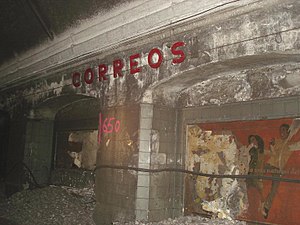Line 3, currently known as Zona Universitària – Trinitat Nova, coloured green and often simply referred to as Línia verda, is a metro line in Barcelona operated by TMB, and therefore part of the fare-integrated ATM transport network of the urban region. This V-shaped line is the result of the junction of two related lines: the original L3 and L3B, in 1982. The central section of L3 has the city's oldest metro stations, built in the mid-1920s, with additions almost every decade since then. All of L3 stations are underground.

Line 4, also known as Trinitat Nova – La Pau, usually called "línia groga", is a line in the Barcelona Metro network operated by TMB, and part of the ATM fare-integrated transport network. It serves the northern districts of the city, and it is being extended to the new major metro and rail stations Estació de la Sagrera and Sagrera-Meridiana.

Line 9 is a completely automated line of the Barcelona Metro network that is currently under construction, with 24 stations open in Barcelona and El Prat de Llobregat, L'Hospitalet de Llobregat, Badalona and Santa Coloma de Gramenet suburbs, since December 2009. The line is currently disconnected in two branches, with a connecting part between the two yet to be built. The Aeroport T1 – Zona Universitària section is called L9 South, and the La Sagrera – Can Zam portion L9 North. Upon completion, it will be the longest underground metro line in Europe.
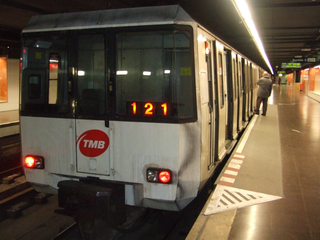
Hospital de Bellvitge, formerly known as Feixa Llarga, is a Barcelona Metro station, in the L'Hospitalet de Llobregat municipality of the Barcelona metropolitan area, and named after the nearby Bellvitge University Hospital. The station is the western terminus of line L1.
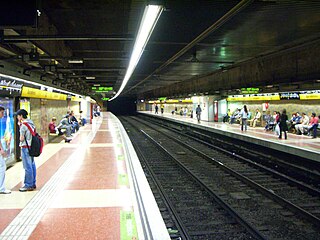
Barceloneta is a station belonging to line L4 of Barcelona Metro. It is located in La Barceloneta neighbourhood, close to the beach and Parc de la Ciutadella. This is the station nearest to Barcelona França railway station, one of the city's major railway stations and one of the R2 commuter line stops.

Plaça d'Espanya, also simply known as Espanya, is an interchange complex underneath Plaça d'Espanya, in the Barcelona district of Sants-Montjuïc, in Catalonia, Spain. It comprises the Barcelona terminus of the Llobregat–Anoia Line and a Barcelona Metro station complex served by lines 1 (L1) and 3 (L3). On the L1, the station is between Hostafrancs and Rocafort, and on the L3 it is between Poble Sec and Tarragona. The Llobregat–Anoia Line station is served by Barcelona Metro line 8 (L8), Baix Llobregat Metro lines S33, S4 and S8, and commuter rail lines R5, R6, R50 and R60. The services on the Llobregat–Anoia Line are operated by Ferrocarrils de la Generalitat de Catalunya (FGC), whilst the L1 and L3 are operated by Transports Metropolitans de Barcelona (TMB).

Zona Universitària is a station in the Barcelona Metro and Trambaix networks, in the Les Corts district of Barcelona. It is currently the western terminus of metro line L3 and L9. Also it's served by tram lines T1, T2 and T3. It is named after the Universitat de Barcelona campus of the same name.

Urquinaona is a station in the Barcelona Metro network, served by TMB lines L1 and L4. One of the metro stations in the city centre, and one of the busiest, it's located underneath Ronda de Sant Pere and Via Laietana, next to Plaça Urquinaona - after which it is named - in the Eixample. It can be accessed from Plaça Urquinaona and Via Laietana.

Lesseps is a station in the Barcelona Metro network, named after its location, Plaça de Lesseps, in the Gràcia district of Barcelona, itself named after Ferdinand de Lesseps, who was appointed French consul in 1842. The station is served by line L3.

Jaume I is a station in the Barcelona Metro network, located under Via Laietana, an important avenue in Ciutat Vella, right between Plaça de Ramon Berenguer el Gran and Plaça d'Emili Vilanova. It can be accessed from Plaça de l'Àngel and Carrer d'Argenteria, on the other side of Via Laietana.

Ciutadella | Vila Olímpica is the name of a station in the Barcelona Metro network, as well of a nearby Trambesòs station in the Sant Martí district of Barcelona. It's named after one of Barcelona's major parks, Parc de la Ciutadella, and La Vila Olímpica del Poblenou, a neighbourhood in the immediate vicinities. It's served by L4, and tram route T4, of which it is a terminus. It was built in 1977 under Parc de Carles I. It was closed between 1991 and 1992 because of infrastructure improvement with the occasion of the 1992 Olympic Games, and again as of mid-2007 due to improvement of L4.

Santa Eulàlia is a Barcelona Metro station, just inside the boundary of the municipality of L'Hospitalet de Llobregat with the city of Barcelona, and named after the nearby Santa Eulàlia neighbourhood. The station is served by line L1.
Europa | Fira is a railway and metro station on the Llobregat–Anoia Line. It is located underneath Gran Via de les Corts Catalanes, near Plaça d'Europa and Carrer d'Amadeu Torner, in the L'Hospitalet de Llobregat municipality, to the south-west of Barcelona, in Catalonia, Spain. Opened on 13 May 2007, it was due to be named Amadeu Torner, in reference to the street of the same name. The station can be accessed from both sidewalks of Gran Via, serving as a major public transport access to the Gran Via business center. It is served by Line 8, Line 9, Baix Llobregat Metro lines S33, S4 and S8, and commuter rail lines R5, R6, R50 and R60.

The Barcelona–Vallès Line is an unconnected standard gauge rapid transit and commuter railway line linking Barcelona with Sabadell and Terrassa via the Collserola mountain range, in Catalonia, Spain. Its name refers to the Catalan historical region of Vallès, whereby most part of the line runs. Plaça de Catalunya station serves as the Barcelona terminus of the line, where almost all its trains either start or terminate. The line then continues northwards and branches off twice before leaving the city limits. Its main route splits in two in Sant Cugat del Vallès, forming two major branches to Sabadell and Terrassa. It has 40 passenger stations in operation and a total line length of 48.1 kilometres (29.9 mi).
Bordeta was a former station on Barcelona Metro line L1, in the Sants-Montjuïc district of the Spanish city of Barcelona. The station site is between the current stations of Mercat Nou and Santa Eulàlia.
Fernando, also called Ferran, is a former Barcelona metro station. The station site is located on line L3 between the existing stations of Liceu and Drassanes, and under the Rambla boulevard.
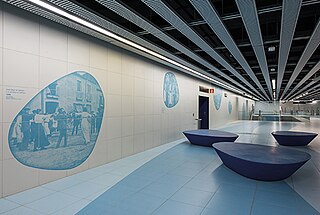
Fira, originally known as Fira 2 – Pedrosa, is a Barcelona Metro station serving Fira de Barcelona's Fira Gran Via major trade fair venue and the Pedrosa industrial park, in the L'Hospitalet de Llobregat municipality, to the south-west of Barcelona. It is situated underneath Avinguda Joan Carles I, at the intersection with Pedrosa and Botànica streets. It has a direct access to Fira Gran Via's main entrance. The station was designed by Japanese architect Toyo Ito.

Banc, also called Banco, is a defunct metro station of the Barcelona metro. Built in 1911 as part of the first Barcelona metro line, it has never been opened to the public.
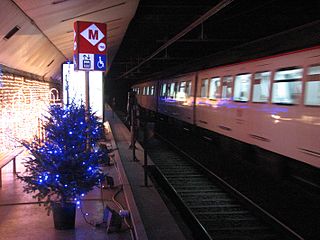
Gaudí is a defunct metro station of the Barcelona Metro. The Line 5 train continues to pass through the station. The upper lobby has been converted into an office for retired TMB workers.

The following outline is provided as an overview of and topical guide to Barcelona:
